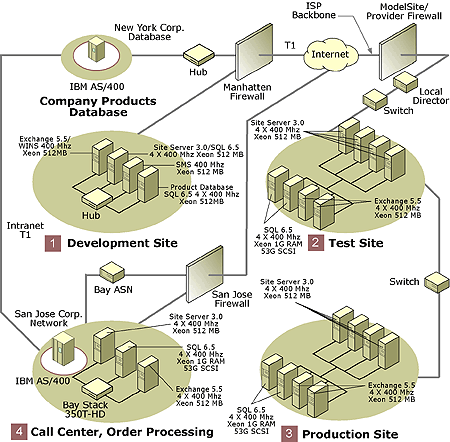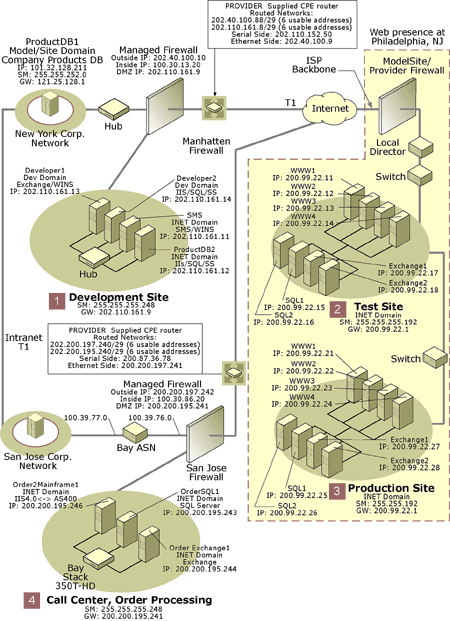

This document contains three diagrams of the site architecture of a sample Site Server 3.0 Commerce Edition (SS3CE) installation (cascadecoffeeroasters.tld). The diagrams are based on a real Site Server Commerce deployment. The diagrams are:
Figure 1 illustrates the architecture and business flow of the sample site, cascadecoffeeroasters.tld:
Figure 1: Architecture and Business Flow Diagram

In the architecture and business flow diagram, you see that Cascade Coffee Roasters has the original catalog and product inventory database on the corporate network, which is run on IBM AS/400 servers. The following table explains the functions of the other sites:
| Site | Site at which… |
| Development (1) | Developers, designers, and testers build and test site configuration and performance.
System administrators also manage the servers at other sites from the development site. |
| Test Site (2) | Testers stress test the system to simulate a real deployment load. The test site exactly duplicates the production site in all respects. |
| Production Site (3) | Internet servers are hosted. |
| Call Center/Order Processing (4) | Orders are entered after they are received from the production site. (Order entry can either be a manual or an automated process.) |
The product database is pulled from the corporate network AS/400s database and sent to the development, test, and production sites’ SQL server. This database update is done after midnight daily to synchronize new product and inventory information.
The Web server and SQL servers are used to serve Web pages and provide product database information. The Microsoft® Exchange servers are used to send order information by e-mail. Orders at the sample site are generated and sent to order entry operators to be entered into the AS/400 database. This process can be streamlined so that orders are entered directly into the AS/400 database, thus eliminating the need for the Exchange email server and manual order entry.
Figure 2 shows how the software and hardware is set up at each of the Cascade Coffee Roasters sites:
Figure 2: Software and Hardware Setup

All computers are equipped with two Compaq Netflex 10/100 Ethernet NIC, Microsoft Windows NT® 4.0 SP3, and Microsoft SQL Server™ 6.5 with SP4.
| Site | Hardware/Software |
| Corporate Network (New York, San Jose) | IBM AS/400s are located at both of the corporate sites. |
| Development Site (1) | The development site is equipped with the following software and hardware:
|
| Test Site (2) | The test site is equipped with the following software and hardware (an exact duplicate of the software and hardware located at the production site):
|
| Production Site (3) |
|
| Call Center/ Order Processing (4) | The call center/order processing is equipped with the following software and hardware:
|
For information on site capacity and performance planning and management, see the Capacity and Performance section of the Site Server 3.0 Commerce Edition Resource Kit, located at http://www.microsoft.com/siteserver/ssrk/rk_list_all_capperf.htm.
Figure 3 shows how the network is set up at each of the Cascade Coffee Roasters sites:
Figure 3: Network Topology

Information in this document, including URL and other Internet web site references, is subject to change without notice. The entire risk of the use or the results of the use of this resource kit remains with the user. This resource kit is not supported and is provided as is without warranty of any kind, either express or implied. The example companies, organizations, products, people and events depicted herein are fictitious. No association with any real company, organization, product, person or event is intended or should be inferred. Complying with all applicable copyright laws is the responsibility of the user. Without limiting the rights under copyright, no part of this document may be reproduced, stored in or introduced into a retrieval system, or transmitted in any form or by any means (electronic, mechanical, photocopying, recording, or otherwise), or for any purpose, without the express written permission of Microsoft Corporation.
Microsoft may have patents, patent applications, trademarks, copyrights, or other intellectual property rights covering subject matter in this document. Except as expressly provided in any written license agreement from Microsoft, the furnishing of this document does not give you any license to these patents, trademarks, copyrights, or other intellectual property.
© 1999-2000 Microsoft Corporation. All rights reserved.
Microsoft, Windows, and Windows NT are either registered trademarks or trademarks of Microsoft Corporation in the U.S.A. and/or other countries/regions.
The names of actual companies and products mentioned herein may be the trademarks of their respective owners.